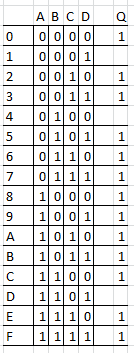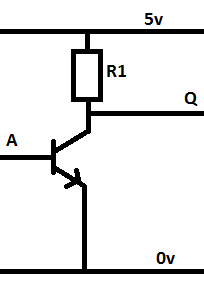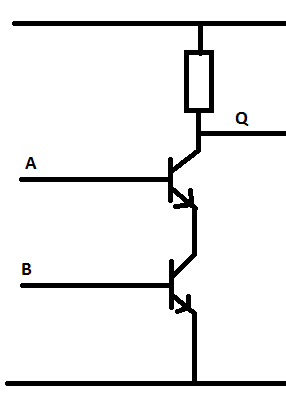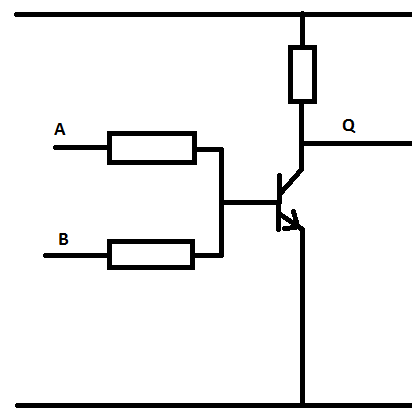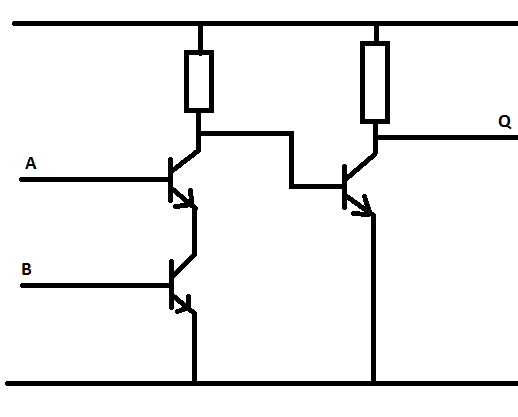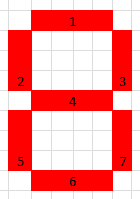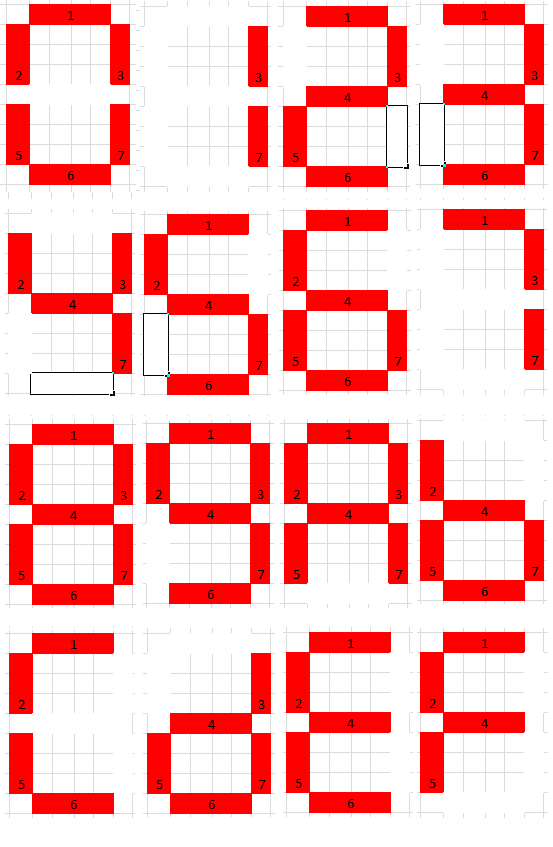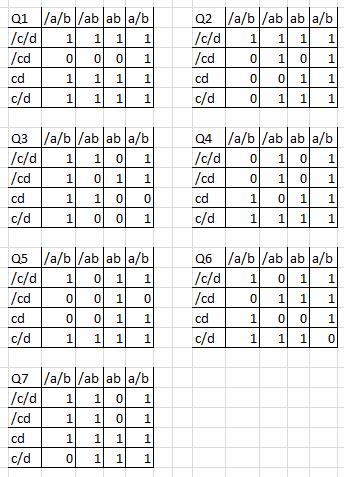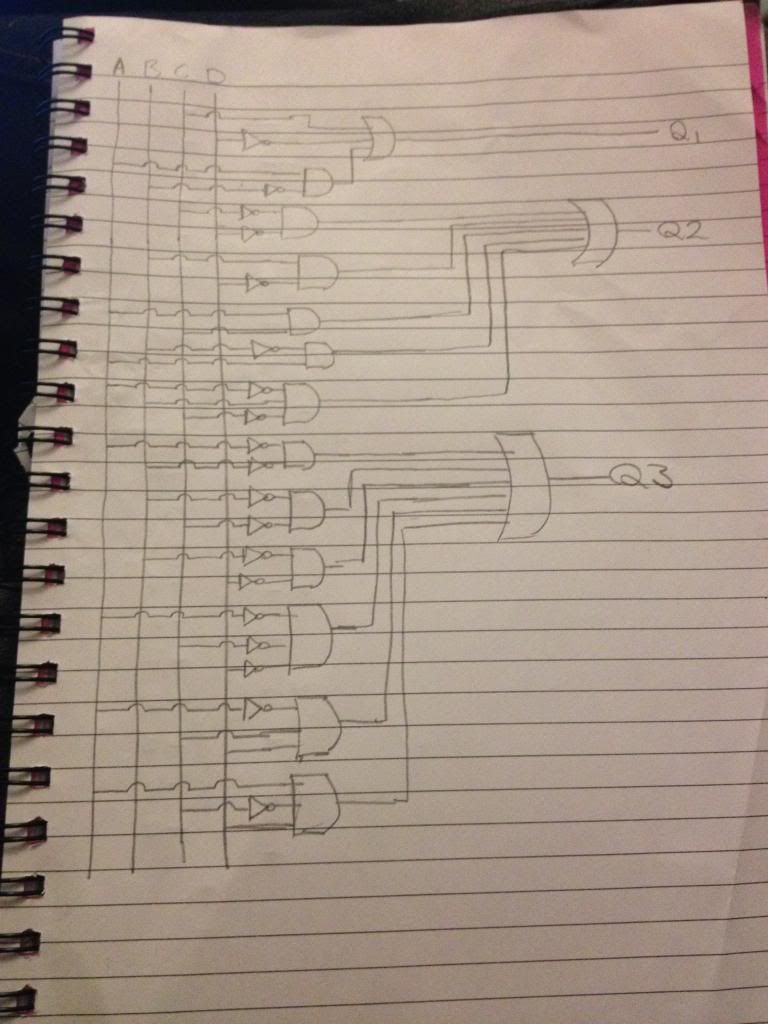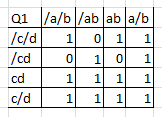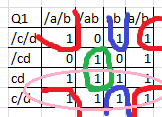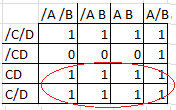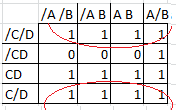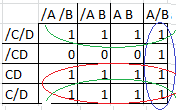So I've looked at boolean algebra, and karnaugh maps.
What you may have realised is, first, binary systems become very big very fast.
But second, Boolean algebra, while useful has some pretty head churning limitations, feasibly there are no limitations, practically it's extraordinarily hard to be able to see what reductions may be created when dealing with more than three or four terms.
Karnaugh maps were a lot easier, yes they did require you to keep your wits about you whilst filling them in, the four by four map was filled logically as row 1 column1, row2 column1, row4 column 1, row 3 column 1. this carried on, but you filled column 1, then 2 then 4 then 3. so you sort of feel like you're jumping all over the place, and the logically last filled cell is at the middle of the table.
On top of that there is also the problem that karnaugh maps have a limitation on the amount of inputs that you can deal with practically, (it's difficult to use with a large number of inputs)
Now I'm going to briefly cover a algorithm called Quine McCluskey.
What makes this different is that it's expressed in a tabular formation. except rather than drawing boxes around the table we look for the number of ones in a given row where the output is true.
In order to demonstrate this I'm going to go back to the seven segment display. remember that first table that showed for each state 0 -15 what the 7 output segments on the 7 segment display needed to show;
0 = 0000 = 1 2 3 5 6 7
1 = 0001 = 3 7
2 = 0010 = 1 3 4 5 6
3 = 0011 = 1 3 4 6 7
4 = 0100 = 2 3 4 7
5 = 0101 = 1 2 4 6 7
6 = 0110 = 1 2 4 5 6 7
7 = 0111 = 1 3 7
8 = 1000 = 1 2 3 4 5 6 7
9 = 1001 = 1 2 3 4 6 7
a = 1010 = 1 2 3 4 5 7
b = 1011 = 1 2 4 5 6 7
c = 1100 = 1 2 5 6
d = 1101 = 3 4 5 6 7
e = 1110 = 1 2 4 5 6
f = 1111 = 1 2 4 5
We'll start the demonstration of Quine McCluskey by looking at the table of outputs for segment 1 of the seven segment display.
Then we draw a new table.
This table looks at the number of 1's in a state,
then the name of the state, (which is called a minterm)
and the binary representation of the state.
Now we look at the minterms and see which ones differ by only one bit.
Then we re-write these terms, using a dash to signify the bit that does not matter.
Look at minterms m14 (1110) and m15 (1111)
These are re-written as m(14 15) 111-
So you add these into that first table now, just a column along.
Mark any min term that cannot be combined, in this first case all minterms can be reduced.
OK, so now we have a table that has our first reduced minterms
It looks like we've got more work to do, yes it does look more complex than when we started, but honestly this is reducing the table!!
Now we need to combine our combined minterms.
To combine the minterms first we looked at where the states were just one bit out like m6[0110] and m14[1110]. became m(6, 14) [-110]
also m15[1111] and m7[0111] became m(7,15) [-111]
now we need to look at the conbined minterms where the dashes are in the same place and that only differ by one bit.
so:
m(6, 14) [-110]
m(7,15) [-111]
becomes
m(6, 7, 14, 15) [-11-]
We can conbine -010 and -110 or -011 or -000, as the dash is in the same place and they only differ by one bit
we can't combine -010 with -111 or -001 or -100 as there are two bits different, and we certainly can't combine -010 with -101 as that's three bit different.
We can't combine -010 with 001- as teh dash is in the wrong place for conbination
To start with just read down the chart and fill in ALL possibilities, we'll remove the repeated values later.
Now we can delete duplicates.
So the table has gotten a little smaller, and we can also see that m(5,7) is reduced as it's going to get. so we but an X next to this.
Now we start looking at the table to see where two dashes match but terms differ by only one value.
m(2,6,10,14) = [- - 1 0]
m(3,7,11,15) = [- - 1 1]
becomes m(2, 3, 6, 7, 10, 11, 14, 15) [ - - 1 - ]
In other words all of these terms can be reduced to the expression C
When you've finished matching the pairs your table should look like this:
now you can see that
m(2,3,6,7,10,11,14,15) - - 1 -
m(2,3,10,11,6,7,14,15) - - 1 - =>m(2,3,6,7,10,11,14,15) - - 1 -
m(2,6,10,14,3,7,11,15) - - 1 - =>m(2,3,6,7,10,11,14,15) - - 1 -
When we organise the minterms in numerical order
I highlighted the none combinable terms, and you can see that since we only have one term left there are no more combinations that can be made.
m(5,7)
m(8,10,12,14)
m(0,2,8,10)
m(2,3,6,7,10,11,14,15)
These minterms represent our prime implicants.
So now we draw a table listing the reduced/combined minterms from the table above.
The states, and their representations
This is called a prime implicant chart.
What this chart represents is the states that must be true.
This example doesn't lead well to what needs to happen next so for a moment pretend that the chart looks like this:
Now we can see that there is minterm2 that is common to two different outputs,
the 8 in the second statement can also be covered by one of the other statements, and the 10 can be covered too.
(so the statement relating to m(2,8,10) [-0-0]{/b./d} could be ignored as it would be covered in other statements.)
In this case where we have a statement that cannot be covered then it's an essential prime implicant, statements where the output states are covered by other statements are non-essential and can be left out.
Back in the real world we do have a minterm 0 on that second statement.
So it looks like they are ALL essential prime implicants.
so our output is m(5,7) OR m(0,2,8,10) OR m(8,10,12,14) + m(2,3,6,7,10,11,14,15)
looking at the values at the end this makes
m(5,7) = (/A . B .D) (the dash in C means C or NOT C, and as we know, A . B + A . /B = A
So we can write out the expression for the gates as:
Q1 = /A . B . D + /B . /D + A . /D + C
Monday, October 29, 2012
Monday, October 22, 2012
Electronics Lessons: Making Gates
So as promised in the last lessons I'm going to start to give a small idea of what these magical logic blocks are made up of. I'm going to draw out some very simplistic circuits that would work as basic logic gates using regular Bipolar Junction transistors.
First we'll start with the NOT gate.
This circuit should look pretty familiar, because it's effectively the inverting amplifier that was made two years ago.
When the base of the transistor is bought high into the saturation region, the transistor conducts, and the collector is connected to ground.
When the base of the transistor is low, (in the cut-off region) the collector of the transistor is connected only to the Vcc voltage through the resistor, and thus the output of the circuit is high.
NAND
It might seem like it's going a little out of order to do the NAND gate next, but it's a very simple addittion to the NOT circuit.
The NOT circuit pulls the output low by providing a path to ground when the transistor is on, the NAND gate works just like this, except there are two transistors that have to be on to provide that path to ground, and those transistors are in series.
(incidentally you could create an NOR gate by having the transistors in parallel)
AND
The output of the NAND gate is the inverse of the AND gate, and visa versa, to make an AND gate (when the output is high when both inputs are high) all we do it put a NOT gate following a NAND gate!
NOR
I said earlier that you could create a NOR gate just like a NAND gate, but instead of having the transistors in series have them in parallel.
You can also just have the base of transistor 1 able to be brought high by either input.
in this scenario the inputs are isolated from each other with the use of resistors.
OR
Just as we turned a NAND gate into an AND gate with an inverter circuit (NOT gate) we do the same to turn the NOR gate into an OR gate.
With these basic gates it should be possible to make any logic circuit that you can imagine, (in fact this is possible with just the NAND gate as discussed in this blog post.
http://ah-screwit.blogspot.co.uk/2012/09/electronics-lessons-making-gates-from.html
First we'll start with the NOT gate.
This circuit should look pretty familiar, because it's effectively the inverting amplifier that was made two years ago.
When the base of the transistor is bought high into the saturation region, the transistor conducts, and the collector is connected to ground.
When the base of the transistor is low, (in the cut-off region) the collector of the transistor is connected only to the Vcc voltage through the resistor, and thus the output of the circuit is high.
NAND
It might seem like it's going a little out of order to do the NAND gate next, but it's a very simple addittion to the NOT circuit.
The NOT circuit pulls the output low by providing a path to ground when the transistor is on, the NAND gate works just like this, except there are two transistors that have to be on to provide that path to ground, and those transistors are in series.
(incidentally you could create an NOR gate by having the transistors in parallel)
AND
The output of the NAND gate is the inverse of the AND gate, and visa versa, to make an AND gate (when the output is high when both inputs are high) all we do it put a NOT gate following a NAND gate!
NOR
I said earlier that you could create a NOR gate just like a NAND gate, but instead of having the transistors in series have them in parallel.
You can also just have the base of transistor 1 able to be brought high by either input.
in this scenario the inputs are isolated from each other with the use of resistors.
OR
Just as we turned a NAND gate into an AND gate with an inverter circuit (NOT gate) we do the same to turn the NOR gate into an OR gate.
With these basic gates it should be possible to make any logic circuit that you can imagine, (in fact this is possible with just the NAND gate as discussed in this blog post.
http://ah-screwit.blogspot.co.uk/2012/09/electronics-lessons-making-gates-from.html
Monday, October 15, 2012
Electronics lessons: Minimalism.
There is a saying that something is complete not when you've put everything that you can into it, but when you've taken everything that you can out of it.
In the last electronics lesson post I looked at creating a simple logic circuit for driving a seven segment display that would display the hex numerals 1 - F. the logic states were reduced using karnaugh maps to a minimalist form and the end circuit was a log circuit that would work very well as a binary - hex decoder.
However, the circuit drawn at the end was very inefficient, there were far more gates than were actually needed, when you consider that it costs time to make each gate, and materials, and die space, having a few extra hundred transistors on a piece of silicone might not sound like a lot, (perhaps it only costs one tenth of one penny to make al lthe extra gates), but when you make millions of devices that soon adds up.
Imagine if the 555 timer had 50 odd extra transistors due to poor design that's a tenth of a penny, for a device that is sold in tens of millions per year, over nearly fifty years.
Sloppy design can cost a lot. if you were making the circuit not on silicone but out of discrete transistors, at a cost of £0.10 per transistor and extra 50 transistors makes your circuit £5 more expensive.
Minimising
So onto minimising the circuit that we made last time.
When we finished we were looking at:
Q1 = C + /D + (A. /B)
Q2 = (/C . /D) + (B . /D) + (A . C) + (A . /B) + (/A . B . /C)
Q3 = (/A . /B) + (/B . /C) + (/B . /D) + ( /A . /C . /D) + (/A . C . D) + (A . /C . D)
Q4 = (A . /B) + (C . /D) + (A . C) + (/B . C) + (/A . B . /C)
Q5 = (C . /D) + (/B . /D) + (A . B)
Q6 = (A . /C) + (/A . /B . /D) + (/B . C . D) + (B . /C . /D) + (B . C . /D)
Q7 = (A . /B) + (/A . B) + (B . C) + (/B . /C) + (/B . D)
as our logic circuit.
Now We can just build these logic circuits one on top of the other, 7 individual circuits, but we can see that some of the elements are the same across each statement for the output.
for example Q1 and Q2 both contain A . /B.
why build them as separate pods, why not build that block once and have it fed to the OR gate that will inevitably be at the output of both the Q1 and Q2 outputs?
So now we need to take our truth statements and look for common elements.
Working through that list also looking for common elements we find:
C = Q1***
/D = Q1***
(A. /B) = Q1, Q2, Q4 Q7
(/C . /D) = Q2, ***
(B . /D) = Q2, ***
(A . C) = Q2, Q4,
(/A . /B) = Q3***
(/B . /C) = Q3, Q7
(/B . /D) = Q3, Q5 ***
(C . /D) = Q4, Q5 ***
(/B . C) = Q4 ***
(A . B) = Q5
(A . /C) - Q6 ***
(/A . B) = Q7 ***
(B . C) = Q7 ***
(/B . D) = Q7 ***
Q2 > (/A . B . /C)
Q3 > ( /A . /C . /D) + (/A . C . D) + (A . /C . D)
Q4 > (/A . B . /C)
Q6 > (/A . /B . /D) + (/B . C . D) + (B . /C . /D) + (B . C . /D)
You'll see that I've written out logical blocks A . /B is by far the most used block in this system, it's used by four different outputs, so instead of repeating this block four times I'll have this as a single block that gets connected to four different outputs.
in fact all the blocks marked with stars are used in some way in the remaining more complex gate arrangements of Q2, Q3, Q4 and Q6 that require 3 inputs)
Some of the blocks only appear to be used once, for example /C . /D only appears in Q2, but /A . /C . /D
you see that if I create a block for /c . /d and just use that in the gate arrangement for Q2 it's a waste, I have to create another block with /c and /d in it and feed these into an AND gate with /A.
So again, why not just re-use the block.
All inputs with stars have got elements that can be used in other gate arrangements.
So Lets divide our circuit into blocks, we can then interconnect the blocks to produce the minimum amount of gates required to build the system. Each building block will be an element that represents a state.
so A = 1 is a state,
B = 1 is a state
A . B is a state that is made up of the two states above.
The idea here is that we only create each state once. creating a state twice is a was of die space/transistors.
To start with we'll define blocks 1 - 4 as A, B, C and D
X1 = A
X2 = B
X3 = C
X4 = D
Then we find that we use /A /B /C and /D everywhere so we'll make use of these too.
X5 = /A
X6 = /B
X7 = /C
X8 = /D
Now we'll start looking at our common blocks.
A . /B seems to be our most common so we'll define this as building block 9
X9 = A . /B = X1 . X6
As we go, we'll remove the statement from the list of 7 output states needed, that way we can be sure that we do not needlessly remake any elements
Q1 =
Q2 = (/C . /D) + (B . /D) + (A . C) + + (/A . B . /C)
Q3 = (/A . /B) + (/B . /C) + (/B . /D) + ( /A . /C . /D) + (/A . C . D) + (A . /C . D)
Q4 = + (C . /D) + (A . C) + (/B . C) + (/A . B . /C)
Q5 = (C . /D) + (/B . /D) + (A . B)
Q6 = (A . /C) + (/A . /B . /D) + (/B . C . D) + (B . /C . /D) + (B . C . /D)
Q7 = + (/A . B) + (B . C) + (/B . /C) + (/B . D)
Next we'll take the output /C . /D and define this as X10
X10 = /C . /D = X7 . X8
this expression is also used in the output for Q3 (/A . /C . /D), and the output of Q6 (B . /C . /D)
so we'll define these as X11 and X12 respectively
X11 = (/A . /C . /D) = X5 . X10
X12 = (B . /C . /D) = X2 . X10
our X13 block will be B . /D this is used in Q2, and in Q6 (B . C . /D) which will be X14
X13 = B . /D = X2 . X8
X14 = (B . C . /D) = X13 . X3
Moving on we have A . C this is used in the output of Q2 and Q4 only (and is not re-used in the more complex gate arrangements)
X15 = A . C = X1 . X3
Moving further down the list we get to /A . /B this is used in Q3 and in Q6 as a part of the condition /A . /B . /D
so...
X16 = /A . /B = X5 . X6
X17 = /A . /B . /DX16 . X8
The condition /B . /C is only used in Q3 and Q7 and forms block 18
X18 = /B . /C = X6 . X7
the next one on the list is interesting, /B . /D is starred, it was used in Q3 and Q5, and in one of the other more complex arrangements (Q6 /A . /B . /D) but we've already taken care of the more complex arrangement in Q6 with block X17, so we needn't worry about catering for this again. X19 therefore is only used for Q3 and Q5 outputs
X19 = /B . /D = X6 . X8
the next state is C . /D this is used in the output of Q4 and Q5, and used in the output of Q6 (when combined with another state). but we already have enough states made to cater for that complex arrangement (which is X14)
X20 = C . /D = X2 . X7
if you've been working through this on paper, removing terms from the original statements as the terms are devised into logic blocks you should now only have this written on your page:
Q1 =
Q2 = (/A . B . /C)
Q3 = (/A . C . D) + (A . /C . D)
Q4 = (/B . C) + (/A . B . /C)
Q5 = (A . B)
Q6 = (A . /C) + (/B . C . D)
Q7 = (/A . B) + (B . C) + (/B . D)
The next term that we're going assign a state value to, (to make it a building block) is /B . C this is used in the output of Q4, and in the more complex statement in Q6 /B . C . D
X21 = /B . C = X6 . X3
X22 = /B . C . D = X21 . X4
Continuing down the list
X23 = A . B = X1 . X2
A . /C is used in output Q3 (with D) and in output Q6
X24 = A . /C = X1 . X7
X25 = A . /C . D = X24 . X4
Then we have /A . B which is used in Q7 and the more complex statements in Q2 and Q4
X26 = /A . B = X5 . X2
X27 = /A . B . /C = X26 . X7
Then we have three non common terms remaining B . C, /B . D, /A . C . D
X28 = B . C = X2 . X3
X29 = /B . D = X6 . X4
X30 = /A . C . D = X5 . X3 . X4
Now we've defined terms as states, where some of the states are made up of other states.
You'll have noticed in the large rather large schematic there were 40 not gates, with this state based arrangements there will only be four as the outputs of states, X1, 2, 3, 4, 5, 6, 7,8 are common to other inputs they form a most basic building block which are used to build other blocks.
We've already at an instant reduced our gate count by 36 gates.
So let's have a look at how many transistors are being used now.
We take our logical statements are replace our logical expressions with our state expressions.
X1 = A
X2 = B
X3 = C
X4 = D
X5 = /A
X6 = /B
X7 = /C
X8 = /D
X9 = A . /B = X1 . X6
X10 = /C . /D = X7 . X8
X11 = (/A . /C . /D) = X5 . X10
X12 = (B . /C . /D) = X2 . X10
X13 = B . /D = X2 . X8
X14 = (B . C . /D) = X13 . X3
X15 = A . C = X1 . X3
X16 = /A . /B = X5 . X6
X17 = /A . /B . /D = X16 . X8
X18 = /B . /C = X6 . X7
X19 = /B . /D = X6 . X8
X20 = C . /D = X2 . X7
X21 = /B . C = X6 . X3
X22 = /B . C . D = X21 . X4
X23 = A . B = X1 . X2
X24 = A . /C = X1 . X7
X25 = A . /C . D = X24 . X4
X26 = /A . B = X5 . X2
X27 = /A . B . /C = X26 . X7
X28 = B . C = X2 . X3
X29 = /B . D = X6 . X4
X30 = /A . C . D = X5 . X3 . X4
(after the first few transformations you have)
Q1 = X3 + X8 + X9
Q2 = (/C . /D) + (B . /D) + (A . C) + X9 + (/A . B . /C)
Q3 = (/A . /B) + (/B . /C) + (/B . /D) + ( /A . /C . /D) + (/A . C . D) + (A . /C . D)
Q4 = X9 + (C . /D) + (A . C) + (/B . C) + (/A . B . /C)
Q5 = (C . /D) + (/B . /D) + (A . B)
Q6 = (A . /C) + (/A . /B . /D) + (/B . C . D) + (B . /C . /D) + (B . C . /D)
Q7 = X9 + (/A . B) + (B . C) + (/B . /C) + (/B . D)
You can see the way that this pattern is forming, Q1 is just going to be three building blocks connected to an Or gate, the X9 building block is going to be used for three other statements, so as well as saving 40 NOT gates, we've saved another 3 AND gates and we've only applied this to three terms at present!
We end up with a list like this.
Q1 = X3 + X8 + X9
Q2 = X10 + X13 + X15 + X9 +X27
Q3 = X16 + X18 + X19 + X11 + X30 + X25
Q4 = X9 + X20 + X15 + X21 + X27
Q5 = X20 + X19 + X23
Q6 = X24 + X17 + X22 + X12 + X14
Q7 = X9 + X26 + X28 + X18 + X29
Now we can start drawing out our Schematic for our gate connections.
We start with A, B, C, D and we label these connections with the state that they are
X1, X2, X3, and X4.
We look at the expression for Q1
Q1 = X3 + X8 + X9
So immediately we can take the output X3 (c) and draw a long line over to where we'll put out final OR gate
Then we have X8, we look to our Key, X8 is /D, or /X4
so we take the output from X4, and feed this through a not gate, we label the new state after the not gate X8, and draw a long line over to where our OR gate will sit.
Finally we have X9. X9 is defined as X1 . X6.
We have X1 already, so we just draw a line to where we're going to place out AND gate, then we look at how to make X6.
X6 is /X2 so we take our X2 output, add a NOT gate, (and label the output X6 ready for use later), then we take our state X6 and feed this into the same AND gate that we connected X1 to.
We label the output of that AND gate X9, and draw a line over to where we're placing our final OR gate.
We now have all three inputs for the OR gate required and so we can put the OR gate in place and label it's output Q1...
The continue for the other statements.
In the statement for Q2 remember when we get to the part that says X9, we already have X9, so rather than adding a new AND gate, we just add a wire, connectting the existing building block X9 to the final OR gate of Q2.
Drawing out the schematic can be an activity left to you.
There are 4 NOT Gates.
23 AND Gates 22 x 2 input gates plus 1 x 3 input AND gate.
and 7 OR gates of varying input size.
That's a reduction of 36 NOT gates, and 16 AND gates. (52 less gates).
Now that we've looked at taking really long and complicated statements such as:
Q1 = /a./b./c./d + /a./b.c./d + /a./b.c.d + /a.b/.c./d + /a.b.c./d + /a.b.c.d + a./b./c./d + a./b./c.d + a./b.c./d + a./b.c.d + a.b./c./d + a.b.c./d + a.b.c.d
and reducing them to:
Q1 = (A . /B) + C + /D
(If you blindly just drew gates for each expression on the first you'd use: 26 NOT gates, 39 (4 input) AND gates and a 12 input OR gates.)
The second statement uses 2 NOT gates, 1 AND gate and a 3 input OR gate.
The question is WHY that's important. you might be thinking I can afford to buy a chip, or a few extra chips with gates in them.
after all a chip with 4 x 2 input AND gates on it is only a few pence, you could even afford to use three of those gates to make your four input AND gate and just ignore the last gate.
But the point is that the expense adds up. for this single statement you can perform ALL the logic needed with just 3 devices, (an array of NOT gates, and array of AND gates, and an array of OR gates), also you'll have gates left over for use in the 7 other output states of the hex decoder.
A chip containing 6 NOT gates costs, £0.20 from Farnell. if you plan to use 25 not gates for this one statement then the costs is £1.20 as you need to buy 6 chips.
If you didn't reduce any of the statements you'd use loads more.
Earlier I looked at combining gate arrays to minimise the amount of gates required, and got the count down to just 4 NOT gates. -that's 1 chip.
So reduction saves £1 in this statement
when we look at the original statements in the making a hex counter the logic needed to drive a seven segment display was:
Q1 = /a./b./c./d + /a./b.c./d + /a./b.c.d + /a.b./c./d + /a.b.c./d + /a.b.c.d + a./b./c./d + a./b./c.d + a./b.c./d + a./b.c.d + a.b./c./d + a.b.c./d + a.b.c.d
Q2 = /a./b./c./d + /a.b./c./d + /a.b./c.d + /a.b.c./d + a./b./c./d + a./b./c.d + a./b.c./d + a./b.c.d + a.b./c./d + a.b.c./d + a.b.c.d
Q3 = /a./b./c./d + /a./b./c.d + /a./b.c./d + /a./b.c.d + /a.b./c./d + /a.b.c.d + a./b./c./d + a./b./c.d + a./b.c./d + a.b./c.d
Q4 = /a./b.c./d + /a./b.c.d + /a.b./c./d + /a.b./c.d + /a.b.c./d + a./b./c./d + a./b./c.d + a./b.c./d + a./b.c.d + a.b./c.d + a.b.c./d + a.b.c.d
Q5 = /a./b./c./d + /a./b.c./d + /a.b.c./d + a./b./c./d + a./b.c./d + a./b.c.d + a.b./c./d + a.b./c.d + a.b.c./d + a.b.c.d
Q6 = /a./b./c./d + /a./b.c./d + /a./b.c.d + /a.b./c.d + /a.b.c./d + a./b./c./d + a./b./c.d + a./b.c.d + a.b./c./d + a.b./c.d + a.b.c./d
Q7 = /a./b./c./d + /a./b./c.d + /a./b.c.d + /a.b./c./d + /a.b./c.d + /a.b.c./d + /a.b.c.d + a./b./c./d + a./b./c.d + a./b.c./d + a./b.c.d + a.b.c./d + a.b.c.d
there are 162 not gates used that's 27 chips £5.40 in chips.
this was reduced to 40 NOT gates (7 chips / £1.40 in chips)
by looking at a series of state machines as building blocks this was furter reduced to 4 NOT gates (£0.20)
Now consider that these surface mount chips containing the arrays of NOT gates are 6 x 9mm,
you'll need perhaps a border of 10mm around each chip to allow for the hundreds of traces that you're going to need to run inter connecting these gates and you end up at. 26 x 29mm
Now you have 27 of these.
That's roughly 150mm x 150mm of board estate needed just for NOT gates, (we still have AND, and OR gates to put into this!!) -well that's for 25 which is a nice 5x5 square...
But for the moment ignore the fact that you can buy chips as pre-made packages.
What if you were making this from Transistors, or what if you were the chip manufacturer making this binary - hex converter in a single package.
162 NOT gates,
240 AND gates,
7 multi input OR gates. (73 x 2 input or gates if you were building with chips)
In the next post I'm going to explain how to make gates from Transistors, this creates TTL (transistor - transistor logic) devices.
After this lesson is complete you'll appreciate why when using TTL it's important to be minimalist, and extra few hundred gates may mean hundreds and hundreds more transistors, and hundreds of extra resistors being fabricated too! this is the same as wasting circuit board space.
Just as it's expensive to make big circuit boards it's expensive to make big chips.
In the last electronics lesson post I looked at creating a simple logic circuit for driving a seven segment display that would display the hex numerals 1 - F. the logic states were reduced using karnaugh maps to a minimalist form and the end circuit was a log circuit that would work very well as a binary - hex decoder.
However, the circuit drawn at the end was very inefficient, there were far more gates than were actually needed, when you consider that it costs time to make each gate, and materials, and die space, having a few extra hundred transistors on a piece of silicone might not sound like a lot, (perhaps it only costs one tenth of one penny to make al lthe extra gates), but when you make millions of devices that soon adds up.
Imagine if the 555 timer had 50 odd extra transistors due to poor design that's a tenth of a penny, for a device that is sold in tens of millions per year, over nearly fifty years.
Sloppy design can cost a lot. if you were making the circuit not on silicone but out of discrete transistors, at a cost of £0.10 per transistor and extra 50 transistors makes your circuit £5 more expensive.
Minimising
So onto minimising the circuit that we made last time.
When we finished we were looking at:
Q1 = C + /D + (A. /B)
Q2 = (/C . /D) + (B . /D) + (A . C) + (A . /B) + (/A . B . /C)
Q3 = (/A . /B) + (/B . /C) + (/B . /D) + ( /A . /C . /D) + (/A . C . D) + (A . /C . D)
Q4 = (A . /B) + (C . /D) + (A . C) + (/B . C) + (/A . B . /C)
Q5 = (C . /D) + (/B . /D) + (A . B)
Q6 = (A . /C) + (/A . /B . /D) + (/B . C . D) + (B . /C . /D) + (B . C . /D)
Q7 = (A . /B) + (/A . B) + (B . C) + (/B . /C) + (/B . D)
as our logic circuit.
Now We can just build these logic circuits one on top of the other, 7 individual circuits, but we can see that some of the elements are the same across each statement for the output.
for example Q1 and Q2 both contain A . /B.
why build them as separate pods, why not build that block once and have it fed to the OR gate that will inevitably be at the output of both the Q1 and Q2 outputs?
So now we need to take our truth statements and look for common elements.
Working through that list also looking for common elements we find:
C = Q1***
/D = Q1***
(A. /B) = Q1, Q2, Q4 Q7
(/C . /D) = Q2, ***
(B . /D) = Q2, ***
(A . C) = Q2, Q4,
(/A . /B) = Q3***
(/B . /C) = Q3, Q7
(/B . /D) = Q3, Q5 ***
(C . /D) = Q4, Q5 ***
(/B . C) = Q4 ***
(A . B) = Q5
(A . /C) - Q6 ***
(/A . B) = Q7 ***
(B . C) = Q7 ***
(/B . D) = Q7 ***
Q2 > (/A . B . /C)
Q3 > ( /A . /C . /D) + (/A . C . D) + (A . /C . D)
Q4 > (/A . B . /C)
Q6 > (/A . /B . /D) + (/B . C . D) + (B . /C . /D) + (B . C . /D)
You'll see that I've written out logical blocks A . /B is by far the most used block in this system, it's used by four different outputs, so instead of repeating this block four times I'll have this as a single block that gets connected to four different outputs.
in fact all the blocks marked with stars are used in some way in the remaining more complex gate arrangements of Q2, Q3, Q4 and Q6 that require 3 inputs)
Some of the blocks only appear to be used once, for example /C . /D only appears in Q2, but /A . /C . /D
you see that if I create a block for /c . /d and just use that in the gate arrangement for Q2 it's a waste, I have to create another block with /c and /d in it and feed these into an AND gate with /A.
So again, why not just re-use the block.
All inputs with stars have got elements that can be used in other gate arrangements.
So Lets divide our circuit into blocks, we can then interconnect the blocks to produce the minimum amount of gates required to build the system. Each building block will be an element that represents a state.
so A = 1 is a state,
B = 1 is a state
A . B is a state that is made up of the two states above.
The idea here is that we only create each state once. creating a state twice is a was of die space/transistors.
To start with we'll define blocks 1 - 4 as A, B, C and D
X1 = A
X2 = B
X3 = C
X4 = D
Then we find that we use /A /B /C and /D everywhere so we'll make use of these too.
X5 = /A
X6 = /B
X7 = /C
X8 = /D
Now we'll start looking at our common blocks.
A . /B seems to be our most common so we'll define this as building block 9
X9 = A . /B = X1 . X6
As we go, we'll remove the statement from the list of 7 output states needed, that way we can be sure that we do not needlessly remake any elements
Q1 =
Q2 = (/C . /D) + (B . /D) + (A . C) + + (/A . B . /C)
Q3 = (/A . /B) + (/B . /C) + (/B . /D) + ( /A . /C . /D) + (/A . C . D) + (A . /C . D)
Q4 = + (C . /D) + (A . C) + (/B . C) + (/A . B . /C)
Q5 = (C . /D) + (/B . /D) + (A . B)
Q6 = (A . /C) + (/A . /B . /D) + (/B . C . D) + (B . /C . /D) + (B . C . /D)
Q7 = + (/A . B) + (B . C) + (/B . /C) + (/B . D)
Next we'll take the output /C . /D and define this as X10
X10 = /C . /D = X7 . X8
this expression is also used in the output for Q3 (/A . /C . /D), and the output of Q6 (B . /C . /D)
so we'll define these as X11 and X12 respectively
X11 = (/A . /C . /D) = X5 . X10
X12 = (B . /C . /D) = X2 . X10
our X13 block will be B . /D this is used in Q2, and in Q6 (B . C . /D) which will be X14
X13 = B . /D = X2 . X8
X14 = (B . C . /D) = X13 . X3
Moving on we have A . C this is used in the output of Q2 and Q4 only (and is not re-used in the more complex gate arrangements)
X15 = A . C = X1 . X3
Moving further down the list we get to /A . /B this is used in Q3 and in Q6 as a part of the condition /A . /B . /D
so...
X16 = /A . /B = X5 . X6
X17 = /A . /B . /DX16 . X8
The condition /B . /C is only used in Q3 and Q7 and forms block 18
X18 = /B . /C = X6 . X7
the next one on the list is interesting, /B . /D is starred, it was used in Q3 and Q5, and in one of the other more complex arrangements (Q6 /A . /B . /D) but we've already taken care of the more complex arrangement in Q6 with block X17, so we needn't worry about catering for this again. X19 therefore is only used for Q3 and Q5 outputs
X19 = /B . /D = X6 . X8
the next state is C . /D this is used in the output of Q4 and Q5, and used in the output of Q6 (when combined with another state). but we already have enough states made to cater for that complex arrangement (which is X14)
X20 = C . /D = X2 . X7
if you've been working through this on paper, removing terms from the original statements as the terms are devised into logic blocks you should now only have this written on your page:
Q1 =
Q2 = (/A . B . /C)
Q3 = (/A . C . D) + (A . /C . D)
Q4 = (/B . C) + (/A . B . /C)
Q5 = (A . B)
Q6 = (A . /C) + (/B . C . D)
Q7 = (/A . B) + (B . C) + (/B . D)
The next term that we're going assign a state value to, (to make it a building block) is /B . C this is used in the output of Q4, and in the more complex statement in Q6 /B . C . D
X21 = /B . C = X6 . X3
X22 = /B . C . D = X21 . X4
Continuing down the list
X23 = A . B = X1 . X2
A . /C is used in output Q3 (with D) and in output Q6
X24 = A . /C = X1 . X7
X25 = A . /C . D = X24 . X4
Then we have /A . B which is used in Q7 and the more complex statements in Q2 and Q4
X26 = /A . B = X5 . X2
X27 = /A . B . /C = X26 . X7
Then we have three non common terms remaining B . C, /B . D, /A . C . D
X28 = B . C = X2 . X3
X29 = /B . D = X6 . X4
X30 = /A . C . D = X5 . X3 . X4
Now we've defined terms as states, where some of the states are made up of other states.
You'll have noticed in the large rather large schematic there were 40 not gates, with this state based arrangements there will only be four as the outputs of states, X1, 2, 3, 4, 5, 6, 7,8 are common to other inputs they form a most basic building block which are used to build other blocks.
We've already at an instant reduced our gate count by 36 gates.
So let's have a look at how many transistors are being used now.
We take our logical statements are replace our logical expressions with our state expressions.
X1 = A
X2 = B
X3 = C
X4 = D
X5 = /A
X6 = /B
X7 = /C
X8 = /D
X9 = A . /B = X1 . X6
X10 = /C . /D = X7 . X8
X11 = (/A . /C . /D) = X5 . X10
X12 = (B . /C . /D) = X2 . X10
X13 = B . /D = X2 . X8
X14 = (B . C . /D) = X13 . X3
X15 = A . C = X1 . X3
X16 = /A . /B = X5 . X6
X17 = /A . /B . /D = X16 . X8
X18 = /B . /C = X6 . X7
X19 = /B . /D = X6 . X8
X20 = C . /D = X2 . X7
X21 = /B . C = X6 . X3
X22 = /B . C . D = X21 . X4
X23 = A . B = X1 . X2
X24 = A . /C = X1 . X7
X25 = A . /C . D = X24 . X4
X26 = /A . B = X5 . X2
X27 = /A . B . /C = X26 . X7
X28 = B . C = X2 . X3
X29 = /B . D = X6 . X4
X30 = /A . C . D = X5 . X3 . X4
(after the first few transformations you have)
Q1 = X3 + X8 + X9
Q2 = (/C . /D) + (B . /D) + (A . C) + X9 + (/A . B . /C)
Q3 = (/A . /B) + (/B . /C) + (/B . /D) + ( /A . /C . /D) + (/A . C . D) + (A . /C . D)
Q4 = X9 + (C . /D) + (A . C) + (/B . C) + (/A . B . /C)
Q5 = (C . /D) + (/B . /D) + (A . B)
Q6 = (A . /C) + (/A . /B . /D) + (/B . C . D) + (B . /C . /D) + (B . C . /D)
Q7 = X9 + (/A . B) + (B . C) + (/B . /C) + (/B . D)
You can see the way that this pattern is forming, Q1 is just going to be three building blocks connected to an Or gate, the X9 building block is going to be used for three other statements, so as well as saving 40 NOT gates, we've saved another 3 AND gates and we've only applied this to three terms at present!
We end up with a list like this.
Q1 = X3 + X8 + X9
Q2 = X10 + X13 + X15 + X9 +X27
Q3 = X16 + X18 + X19 + X11 + X30 + X25
Q4 = X9 + X20 + X15 + X21 + X27
Q5 = X20 + X19 + X23
Q6 = X24 + X17 + X22 + X12 + X14
Q7 = X9 + X26 + X28 + X18 + X29
Now we can start drawing out our Schematic for our gate connections.
We start with A, B, C, D and we label these connections with the state that they are
X1, X2, X3, and X4.
We look at the expression for Q1
Q1 = X3 + X8 + X9
So immediately we can take the output X3 (c) and draw a long line over to where we'll put out final OR gate
Then we have X8, we look to our Key, X8 is /D, or /X4
so we take the output from X4, and feed this through a not gate, we label the new state after the not gate X8, and draw a long line over to where our OR gate will sit.
Finally we have X9. X9 is defined as X1 . X6.
We have X1 already, so we just draw a line to where we're going to place out AND gate, then we look at how to make X6.
X6 is /X2 so we take our X2 output, add a NOT gate, (and label the output X6 ready for use later), then we take our state X6 and feed this into the same AND gate that we connected X1 to.
We label the output of that AND gate X9, and draw a line over to where we're placing our final OR gate.
We now have all three inputs for the OR gate required and so we can put the OR gate in place and label it's output Q1...
The continue for the other statements.
In the statement for Q2 remember when we get to the part that says X9, we already have X9, so rather than adding a new AND gate, we just add a wire, connectting the existing building block X9 to the final OR gate of Q2.
Drawing out the schematic can be an activity left to you.
There are 4 NOT Gates.
23 AND Gates 22 x 2 input gates plus 1 x 3 input AND gate.
and 7 OR gates of varying input size.
That's a reduction of 36 NOT gates, and 16 AND gates. (52 less gates).
Now that we've looked at taking really long and complicated statements such as:
Q1 = /a./b./c./d + /a./b.c./d + /a./b.c.d + /a.b/.c./d + /a.b.c./d + /a.b.c.d + a./b./c./d + a./b./c.d + a./b.c./d + a./b.c.d + a.b./c./d + a.b.c./d + a.b.c.d
and reducing them to:
Q1 = (A . /B) + C + /D
(If you blindly just drew gates for each expression on the first you'd use: 26 NOT gates, 39 (4 input) AND gates and a 12 input OR gates.)
The second statement uses 2 NOT gates, 1 AND gate and a 3 input OR gate.
The question is WHY that's important. you might be thinking I can afford to buy a chip, or a few extra chips with gates in them.
after all a chip with 4 x 2 input AND gates on it is only a few pence, you could even afford to use three of those gates to make your four input AND gate and just ignore the last gate.
But the point is that the expense adds up. for this single statement you can perform ALL the logic needed with just 3 devices, (an array of NOT gates, and array of AND gates, and an array of OR gates), also you'll have gates left over for use in the 7 other output states of the hex decoder.
A chip containing 6 NOT gates costs, £0.20 from Farnell. if you plan to use 25 not gates for this one statement then the costs is £1.20 as you need to buy 6 chips.
If you didn't reduce any of the statements you'd use loads more.
Earlier I looked at combining gate arrays to minimise the amount of gates required, and got the count down to just 4 NOT gates. -that's 1 chip.
So reduction saves £1 in this statement
when we look at the original statements in the making a hex counter the logic needed to drive a seven segment display was:
Q1 = /a./b./c./d + /a./b.c./d + /a./b.c.d + /a.b./c./d + /a.b.c./d + /a.b.c.d + a./b./c./d + a./b./c.d + a./b.c./d + a./b.c.d + a.b./c./d + a.b.c./d + a.b.c.d
Q2 = /a./b./c./d + /a.b./c./d + /a.b./c.d + /a.b.c./d + a./b./c./d + a./b./c.d + a./b.c./d + a./b.c.d + a.b./c./d + a.b.c./d + a.b.c.d
Q3 = /a./b./c./d + /a./b./c.d + /a./b.c./d + /a./b.c.d + /a.b./c./d + /a.b.c.d + a./b./c./d + a./b./c.d + a./b.c./d + a.b./c.d
Q4 = /a./b.c./d + /a./b.c.d + /a.b./c./d + /a.b./c.d + /a.b.c./d + a./b./c./d + a./b./c.d + a./b.c./d + a./b.c.d + a.b./c.d + a.b.c./d + a.b.c.d
Q5 = /a./b./c./d + /a./b.c./d + /a.b.c./d + a./b./c./d + a./b.c./d + a./b.c.d + a.b./c./d + a.b./c.d + a.b.c./d + a.b.c.d
Q6 = /a./b./c./d + /a./b.c./d + /a./b.c.d + /a.b./c.d + /a.b.c./d + a./b./c./d + a./b./c.d + a./b.c.d + a.b./c./d + a.b./c.d + a.b.c./d
Q7 = /a./b./c./d + /a./b./c.d + /a./b.c.d + /a.b./c./d + /a.b./c.d + /a.b.c./d + /a.b.c.d + a./b./c./d + a./b./c.d + a./b.c./d + a./b.c.d + a.b.c./d + a.b.c.d
there are 162 not gates used that's 27 chips £5.40 in chips.
this was reduced to 40 NOT gates (7 chips / £1.40 in chips)
by looking at a series of state machines as building blocks this was furter reduced to 4 NOT gates (£0.20)
Now consider that these surface mount chips containing the arrays of NOT gates are 6 x 9mm,
you'll need perhaps a border of 10mm around each chip to allow for the hundreds of traces that you're going to need to run inter connecting these gates and you end up at. 26 x 29mm
Now you have 27 of these.
That's roughly 150mm x 150mm of board estate needed just for NOT gates, (we still have AND, and OR gates to put into this!!) -well that's for 25 which is a nice 5x5 square...
But for the moment ignore the fact that you can buy chips as pre-made packages.
What if you were making this from Transistors, or what if you were the chip manufacturer making this binary - hex converter in a single package.
162 NOT gates,
240 AND gates,
7 multi input OR gates. (73 x 2 input or gates if you were building with chips)
In the next post I'm going to explain how to make gates from Transistors, this creates TTL (transistor - transistor logic) devices.
After this lesson is complete you'll appreciate why when using TTL it's important to be minimalist, and extra few hundred gates may mean hundreds and hundreds more transistors, and hundreds of extra resistors being fabricated too! this is the same as wasting circuit board space.
Just as it's expensive to make big circuit boards it's expensive to make big chips.
Monday, October 08, 2012
Electronics lessons: Displaying Hexadecimal values on a seven segment display.
All this logic stuff is getting a bit dry, sure, we're able to express systems as a function of inputs and outputs.
We can reduce using boolean algebra, we know how to use truth tables, Karnaugh maps turned out to be a great tool for quick reduction.
But so far we haven't actually designed a system at all...
In order to make the lesson a little more interesting I'm now going to design a logic array for taking a binary number, and displaying the output in hexadecimal.
To do this We're going to use a seven segment LED display.
These displays are LED arrays arranged in a figure 8 shape, and can be used to express values by lighting LEDs.
We'll assign each bar of the display a value.
Then we can draw out what we want to display to show for each number.
We use this chart above to draw out a map of what we want our output states to be for any given input value.
To do this we draw a truth table, with input states, and our output states for the given input states.
From this truth table we can write out what logical expression we want each of our inputs to be on for.
0 = 0000 = 1 2 3 5 6 7
1 = 0001 = 3 7
2 = 0010 = 1 3 4 5 6
3 = 0011 = 1 3 4 6 7
4 = 0100 = 2 3 4 7
5 = 0101 = 1 2 4 6 7
6 = 0110 = 1 2 4 5 6 7
7 = 0111 = 1 3 7
8 = 1000 = 1 2 3 4 5 6 7
9 = 1001 = 1 2 3 4 6 7
a = 1010 = 1 2 3 4 5 7
b = 1011 = 1 2 4 5 6 7
c = 1100 = 1 2 5 6
d = 1101 = 3 4 5 6 7
e = 1110 = 1 2 4 5 6
f = 1111 = 1 2 4 5
so you can see that segment 1 of the display must be lit for states 0, 2, 3, 5, 6, 7, 8, 9, a, b, c, e and f
our inputs ABCD are listed for each state, so we write down the state of our inputs.
state 0 = /a . /b . /c . /d
state 2 = /a . /b . c . /d
So on and so fourth until we've got all 13 states.
then instead of saying Q1 = State0 OR state2...
we say:
Q1 = /a./b./c./d + /a./b.c./d + /a./b.c.d + /a.b/.c./d + /a.b.c./d + /a.b.c.d + a./b./c./d + a./b./c.d + a./b.c./d + a./b.c.d + a.b./c./d + a.b.c./d + a.b.c.d
We then continue this for the rest of the expected output states.
And reach the following statements:
Output States
Q1 = 0 2 3 5 6 7 8 9 a b c e f
Q2 = 0 4 5 6 8 9 a b c e f
Q3 = 0 1 2 3 4 7 8 9 a d
Q4 = 2 3 4 5 6 8 9 a b d e f
Q5 = 0 2 6 8 a b c d e f
Q6 = 0 2 3 5 6 8 9 b c d e
Q7 = 0 1 3 4 5 6 7 8 9 a b e f
Q1 = /a./b./c./d + /a./b.c./d + /a./b.c.d + /a.b./c./d + /a.b.c./d + /a.b.c.d + a./b./c./d + a./b./c.d + a./b.c./d + a./b.c.d + a.b./c./d + a.b.c./d + a.b.c.d
Q2 = /a./b./c./d + /a.b./c./d + /a.b./c.d + /a.b.c./d + a./b./c./d + a./b./c.d + a./b.c./d + a./b.c.d + a.b./c./d + a.b.c./d + a.b.c.d
Q3 = /a./b./c./d + /a./b./c.d + /a./b.c./d + /a./b.c.d + /a.b./c./d + /a.b.c.d + a./b./c./d + a./b./c.d + a./b.c./d + a.b./c.d
Q4 = /a./b.c./d + /a./b.c.d + /a.b./c./d + /a.b./c.d + /a.b.c./d + a./b./c./d + a./b./c.d + a./b.c./d + a./b.c.d + a.b./c.d + a.b.c./d + a.b.c.d
Q5 = /a./b./c./d + /a./b.c./d + /a.b.c./d + a./b./c./d + a./b.c./d + a./b.c.d + a.b./c./d + a.b./c.d + a.b.c./d + a.b.c.d
Q6 = /a./b./c./d + /a./b.c./d + /a./b.c.d + /a.b./c.d + /a.b.c./d + a./b./c./d + a./b./c.d + a./b.c.d + a.b./c./d + a.b./c.d + a.b.c./d
Q7 = /a./b./c./d + /a./b./c.d + /a./b.c.d + /a.b./c./d + /a.b./c.d + /a.b.c./d + /a.b.c.d + a./b./c./d + a./b./c.d + a./b.c./d + a./b.c.d + a.b.c./d + a.b.c.d
So now we can draw out the karnaugh maps for reducing these statements to their minimal form.
Then we start with looping groups of 1, 2, 4, 8 and 16.
Remembering that maps can loop around the top to the bottom, and that maps can loop left to right, and across the corners. (see Q3, Q5 and Q6 for an example of this):
Q1 = C + /D + (A. /B)
Q2 = (/C . /D) + (B . /D) + (A . C) + (A . /B) + (/A . B . /C)
Q3 = (/A . /B) + (/B . /C) + (/B . /D) + ( /A . /C . /D) + (/A . C . D) + (A . /C . D)
Q4 = (A . /B) + (C . /D) + (A . C) + (/B . C) + (/A . B . /C)
Q5 = (C . /D) + (/B . /D) + (A . B)
Q6 = (A . /C) + (/A . /B . /D) + (/B . C . D) + (B . /C . /D) + (B . C . /D)
Q7 = (A . /B) + (/A . B) + (B . C) + (/B . /C) + (/B . D)
So now we'll build a schematic for this circuit.
There is a start for the first few outputs. feel free to finish it!
There are in total.
40 NOT gates
39 AND Gates, 31 x 2 input gates and 8 x 3 input gates
And of course 7 OR gates of varying input sizes
Note: After reviewing this I've noticed that there is a mistake for the output Q1.
This should have been minimised as so.
giving the final equation of Q1 = /A . B . D + /B . /D + A . /D + C
if you use the logic derrived in the first part of this post then you'll find that the output for Q1 on states 4 and 5 will be back to front.
e.g. the top bar will light for 4, making it look like a 9 without a tail.
the top bar will not light for 5 making it look like an upside down question mark
We can reduce using boolean algebra, we know how to use truth tables, Karnaugh maps turned out to be a great tool for quick reduction.
But so far we haven't actually designed a system at all...
In order to make the lesson a little more interesting I'm now going to design a logic array for taking a binary number, and displaying the output in hexadecimal.
To do this We're going to use a seven segment LED display.
These displays are LED arrays arranged in a figure 8 shape, and can be used to express values by lighting LEDs.
We'll assign each bar of the display a value.
Then we can draw out what we want to display to show for each number.
We use this chart above to draw out a map of what we want our output states to be for any given input value.
To do this we draw a truth table, with input states, and our output states for the given input states.
From this truth table we can write out what logical expression we want each of our inputs to be on for.
0 = 0000 = 1 2 3 5 6 7
1 = 0001 = 3 7
2 = 0010 = 1 3 4 5 6
3 = 0011 = 1 3 4 6 7
4 = 0100 = 2 3 4 7
5 = 0101 = 1 2 4 6 7
6 = 0110 = 1 2 4 5 6 7
7 = 0111 = 1 3 7
8 = 1000 = 1 2 3 4 5 6 7
9 = 1001 = 1 2 3 4 6 7
a = 1010 = 1 2 3 4 5 7
b = 1011 = 1 2 4 5 6 7
c = 1100 = 1 2 5 6
d = 1101 = 3 4 5 6 7
e = 1110 = 1 2 4 5 6
f = 1111 = 1 2 4 5
so you can see that segment 1 of the display must be lit for states 0, 2, 3, 5, 6, 7, 8, 9, a, b, c, e and f
our inputs ABCD are listed for each state, so we write down the state of our inputs.
state 0 = /a . /b . /c . /d
state 2 = /a . /b . c . /d
So on and so fourth until we've got all 13 states.
then instead of saying Q1 = State0 OR state2...
we say:
Q1 = /a./b./c./d + /a./b.c./d + /a./b.c.d + /a.b/.c./d + /a.b.c./d + /a.b.c.d + a./b./c./d + a./b./c.d + a./b.c./d + a./b.c.d + a.b./c./d + a.b.c./d + a.b.c.d
We then continue this for the rest of the expected output states.
And reach the following statements:
Output States
Q1 = 0 2 3 5 6 7 8 9 a b c e f
Q2 = 0 4 5 6 8 9 a b c e f
Q3 = 0 1 2 3 4 7 8 9 a d
Q4 = 2 3 4 5 6 8 9 a b d e f
Q5 = 0 2 6 8 a b c d e f
Q6 = 0 2 3 5 6 8 9 b c d e
Q7 = 0 1 3 4 5 6 7 8 9 a b e f
Q1 = /a./b./c./d + /a./b.c./d + /a./b.c.d + /a.b./c./d + /a.b.c./d + /a.b.c.d + a./b./c./d + a./b./c.d + a./b.c./d + a./b.c.d + a.b./c./d + a.b.c./d + a.b.c.d
Q2 = /a./b./c./d + /a.b./c./d + /a.b./c.d + /a.b.c./d + a./b./c./d + a./b./c.d + a./b.c./d + a./b.c.d + a.b./c./d + a.b.c./d + a.b.c.d
Q3 = /a./b./c./d + /a./b./c.d + /a./b.c./d + /a./b.c.d + /a.b./c./d + /a.b.c.d + a./b./c./d + a./b./c.d + a./b.c./d + a.b./c.d
Q4 = /a./b.c./d + /a./b.c.d + /a.b./c./d + /a.b./c.d + /a.b.c./d + a./b./c./d + a./b./c.d + a./b.c./d + a./b.c.d + a.b./c.d + a.b.c./d + a.b.c.d
Q5 = /a./b./c./d + /a./b.c./d + /a.b.c./d + a./b./c./d + a./b.c./d + a./b.c.d + a.b./c./d + a.b./c.d + a.b.c./d + a.b.c.d
Q6 = /a./b./c./d + /a./b.c./d + /a./b.c.d + /a.b./c.d + /a.b.c./d + a./b./c./d + a./b./c.d + a./b.c.d + a.b./c./d + a.b./c.d + a.b.c./d
Q7 = /a./b./c./d + /a./b./c.d + /a./b.c.d + /a.b./c./d + /a.b./c.d + /a.b.c./d + /a.b.c.d + a./b./c./d + a./b./c.d + a./b.c./d + a./b.c.d + a.b.c./d + a.b.c.d
So now we can draw out the karnaugh maps for reducing these statements to their minimal form.
Then we start with looping groups of 1, 2, 4, 8 and 16.
Remembering that maps can loop around the top to the bottom, and that maps can loop left to right, and across the corners. (see Q3, Q5 and Q6 for an example of this):
Q1 = C + /D + (A. /B)
Q2 = (/C . /D) + (B . /D) + (A . C) + (A . /B) + (/A . B . /C)
Q3 = (/A . /B) + (/B . /C) + (/B . /D) + ( /A . /C . /D) + (/A . C . D) + (A . /C . D)
Q4 = (A . /B) + (C . /D) + (A . C) + (/B . C) + (/A . B . /C)
Q5 = (C . /D) + (/B . /D) + (A . B)
Q6 = (A . /C) + (/A . /B . /D) + (/B . C . D) + (B . /C . /D) + (B . C . /D)
Q7 = (A . /B) + (/A . B) + (B . C) + (/B . /C) + (/B . D)
So now we'll build a schematic for this circuit.
There is a start for the first few outputs. feel free to finish it!
There are in total.
40 NOT gates
39 AND Gates, 31 x 2 input gates and 8 x 3 input gates
And of course 7 OR gates of varying input sizes
Note: After reviewing this I've noticed that there is a mistake for the output Q1.
This should have been minimised as so.
giving the final equation of Q1 = /A . B . D + /B . /D + A . /D + C
if you use the logic derrived in the first part of this post then you'll find that the output for Q1 on states 4 and 5 will be back to front.
e.g. the top bar will light for 4, making it look like a 9 without a tail.
the top bar will not light for 5 making it look like an upside down question mark
Monday, October 01, 2012
Electronics Lessons: Reducing logical expressions using Karnaguh maps.
Up to now I've talked about systems that have only a couple of inputs.
In this tutorial I'm going to look at designing a system that has two inputs, or three inputs, or four inputs.
Karnaugh maps
Karnaugh maps are a design tool used for reducing binary expressions. the idea of a kanaugh maps is to look at the inputs to a system and the outputs of a system and write them down in such a way that they can be grouped together.
First we'll consider a very simple system.
We've got two inputs, (A and B)
We look at the system and we say.
when I apply logic 0 to input A, and logic 0 to input B the output Q is 0
when I apply logic 0 to input A, and logic 1 to input B the output Q is 0
when I apply logic 1 to input A, and logic 0 to input B the output Q is 0
when I apply logic 1 to input A, and logic 1 to input B the output Q is 1
so we draw a table that is two columns wide, and 2 rows deep.
the columns are representing input A, whilst the rows represent input B.
in the table there are four spaces, these correspond to the output state.
We then Circle the input such that we group in blocks of 1, or 2 or 4 (in squares or rectangles.)
Here we've circles a block of 1.
This tells us the output is high for conditions of A . B, we've reduced the four statements into a single statement.
A different system may have the outputs
when I apply logic 0 to input A, and logic 0 to input B the output Q is 0
when I apply logic 0 to input A, and logic 1 to input B the output Q is 1
when I apply logic 1 to input A, and logic 0 to input B the output Q is 1
when I apply logic 1 to input A, and logic 1 to input B the output Q is 1
You see when we start making circles on the map this time there is two blocks of 2.
so our out put is high for conditions of A High, or conditions of B High.
We've reduced the map to A + B
2 input systems are a bit simple, and possibly faster to see worked out in your head faster than writing a map out.
however, as a system gets more complex adding more inputs they boolean algebra involved also gets more complex, and this is where karnaugh maps start to be really useful.
Three Input Karnaugh Maps
Assume that we're dealing with a three input system where we have outputs for the following conditions.
(/a . /b . /c) + (/a . b . /c) + (/a . b . c) + (a . /b . c)
Now to draw this karnaugh map we use four columns along the top to show states of A nd B, with two rows to show what state C is.
But each column can only differ by one single value.
this means that you can change either input A OR in put A as you move across the columns, but not both at once.
so you can't go 00, 01 10, 11 the step from 01 to 10 changes A and B at the same time
so your column headers must go 00 01 11 10
You see in this Map there are two groups of two, and a single logic high on it's own.
This means that we can reduce the statement
(/a . /b . /c) + (/a . b . /c) + (/a . b . c) + (a . /b . c)
to
(/a . /c) + (/a . b) + (a . /b .c)
Four input Karnaugh maps
For a four input karnaugh map we must use inputs a, b, c and d this means we need four rows as well as four columns, though again each time the column must not differ by more than one value at a time.
In this example we'll use the logic statement.
Q1 = /a./b./c./d + /a./b.c./d + /a./b.c.d + /a.b./c./d + /a.b.c./d + /a.b.c.d + a./b./c./d + a./b./c.d + a./b.c./d + a./b.c.d + a.b./c./d + a.b.c./d + a.b.c.d
To fill in the karnaugh map we read through the statement filling in the corresponding box on the map where the statements match.
there are 13 parts of the statement;
1 /a./b./c./d +
2 /a./b.c./d +
3 /a./b.c.d +
4 /a.b./c./d +
5 /a.b.c./d +
6 /a.b.c.d +
7 a./b./c./d +
8 a./b./c.d
9 a./b.c./d +
10 a./b.c.d +
11 a.b./c./d +
12 a.b.c./d +
13 a.b.c.d
so the map is filled in like so:
now we replace with ones and zeros...
And we start grouping blocks of logic highs together. - grouping squares and rectangles of 1, 2, 4, 8, or 16 (obviously if we could group a block of 16 that's mean that the output was high no matter what.
We start by grouping the block of 8 at the bottom.
The common value here is C
we can see that when C is high the output of the system is high no matter what else happens in the system.
Now it looks like we have two groups of four left, (which would make the final statement, C . (/C . /D) + (A . /B)
But karnaugh maps can wrap around on themselves.
We make our loops to group logic highs where the inputs are only 1 value changed.
the first and fourth row only have 1 value changed (the value of C) so we create a loop that goes off the bottom of the table and comes back to the top.
So our logic statement is now C OR /D
Now we look at the final block of grouped values, which is the column at the end.
The consistent values here are A . /B, C and D can be anything.
The complete map looks like this:
Leaving our complete logic statement as
Red loop conditions OR Green Loop conditions OR Blue loop conditions
C + /D + (A . /B)
Q1 = /a./b./c./d + /a./b.c./d + /a./b.c.d + /a.b./c./d + /a.b.c./d + /a.b.c.d + a./b./c./d + a./b./c.d + a./b.c./d + a./b.c.d + a.b./c./d + a.b.c./d + a.b.c.d
or Q1 = C + /D + (A . /B)
Which I'm sure you'll agree is a pretty fantastic reduction, from 13 conditions down to just 3.
In this tutorial I'm going to look at designing a system that has two inputs, or three inputs, or four inputs.
Karnaugh maps
Karnaugh maps are a design tool used for reducing binary expressions. the idea of a kanaugh maps is to look at the inputs to a system and the outputs of a system and write them down in such a way that they can be grouped together.
First we'll consider a very simple system.
We've got two inputs, (A and B)
We look at the system and we say.
when I apply logic 0 to input A, and logic 0 to input B the output Q is 0
when I apply logic 0 to input A, and logic 1 to input B the output Q is 0
when I apply logic 1 to input A, and logic 0 to input B the output Q is 0
when I apply logic 1 to input A, and logic 1 to input B the output Q is 1
so we draw a table that is two columns wide, and 2 rows deep.
the columns are representing input A, whilst the rows represent input B.
in the table there are four spaces, these correspond to the output state.
We then Circle the input such that we group in blocks of 1, or 2 or 4 (in squares or rectangles.)
Here we've circles a block of 1.
This tells us the output is high for conditions of A . B, we've reduced the four statements into a single statement.
A different system may have the outputs
when I apply logic 0 to input A, and logic 0 to input B the output Q is 0
when I apply logic 0 to input A, and logic 1 to input B the output Q is 1
when I apply logic 1 to input A, and logic 0 to input B the output Q is 1
when I apply logic 1 to input A, and logic 1 to input B the output Q is 1
You see when we start making circles on the map this time there is two blocks of 2.
so our out put is high for conditions of A High, or conditions of B High.
We've reduced the map to A + B
2 input systems are a bit simple, and possibly faster to see worked out in your head faster than writing a map out.
however, as a system gets more complex adding more inputs they boolean algebra involved also gets more complex, and this is where karnaugh maps start to be really useful.
Three Input Karnaugh Maps
Assume that we're dealing with a three input system where we have outputs for the following conditions.
(/a . /b . /c) + (/a . b . /c) + (/a . b . c) + (a . /b . c)
Now to draw this karnaugh map we use four columns along the top to show states of A nd B, with two rows to show what state C is.
But each column can only differ by one single value.
this means that you can change either input A OR in put A as you move across the columns, but not both at once.
so you can't go 00, 01 10, 11 the step from 01 to 10 changes A and B at the same time
so your column headers must go 00 01 11 10
You see in this Map there are two groups of two, and a single logic high on it's own.
This means that we can reduce the statement
(/a . /b . /c) + (/a . b . /c) + (/a . b . c) + (a . /b . c)
to
(/a . /c) + (/a . b) + (a . /b .c)
Four input Karnaugh maps
For a four input karnaugh map we must use inputs a, b, c and d this means we need four rows as well as four columns, though again each time the column must not differ by more than one value at a time.
In this example we'll use the logic statement.
Q1 = /a./b./c./d + /a./b.c./d + /a./b.c.d + /a.b./c./d + /a.b.c./d + /a.b.c.d + a./b./c./d + a./b./c.d + a./b.c./d + a./b.c.d + a.b./c./d + a.b.c./d + a.b.c.d
To fill in the karnaugh map we read through the statement filling in the corresponding box on the map where the statements match.
there are 13 parts of the statement;
1 /a./b./c./d +
2 /a./b.c./d +
3 /a./b.c.d +
4 /a.b./c./d +
5 /a.b.c./d +
6 /a.b.c.d +
7 a./b./c./d +
8 a./b./c.d
9 a./b.c./d +
10 a./b.c.d +
11 a.b./c./d +
12 a.b.c./d +
13 a.b.c.d
so the map is filled in like so:
now we replace with ones and zeros...
And we start grouping blocks of logic highs together. - grouping squares and rectangles of 1, 2, 4, 8, or 16 (obviously if we could group a block of 16 that's mean that the output was high no matter what.
We start by grouping the block of 8 at the bottom.
The common value here is C
we can see that when C is high the output of the system is high no matter what else happens in the system.
Now it looks like we have two groups of four left, (which would make the final statement, C . (/C . /D) + (A . /B)
But karnaugh maps can wrap around on themselves.
We make our loops to group logic highs where the inputs are only 1 value changed.
the first and fourth row only have 1 value changed (the value of C) so we create a loop that goes off the bottom of the table and comes back to the top.
So our logic statement is now C OR /D
Now we look at the final block of grouped values, which is the column at the end.
The consistent values here are A . /B, C and D can be anything.
The complete map looks like this:
Leaving our complete logic statement as
Red loop conditions OR Green Loop conditions OR Blue loop conditions
C + /D + (A . /B)
Q1 = /a./b./c./d + /a./b.c./d + /a./b.c.d + /a.b./c./d + /a.b.c./d + /a.b.c.d + a./b./c./d + a./b./c.d + a./b.c./d + a./b.c.d + a.b./c./d + a.b.c./d + a.b.c.d
or Q1 = C + /D + (A . /B)
Which I'm sure you'll agree is a pretty fantastic reduction, from 13 conditions down to just 3.
Subscribe to:
Posts (Atom)
